Diabetes and CKD
VerifiedAdded on 2023/01/24
|9
|2394
|64
AI Summary
This article explores the relationship between diabetes and chronic kidney disease, highlighting the impact of high blood sugar on the kidneys and discussing potential treatment options. It also addresses the concerns and considerations for patients with both conditions.
Contribute Materials
Your contribution can guide someone’s learning journey. Share your
documents today.
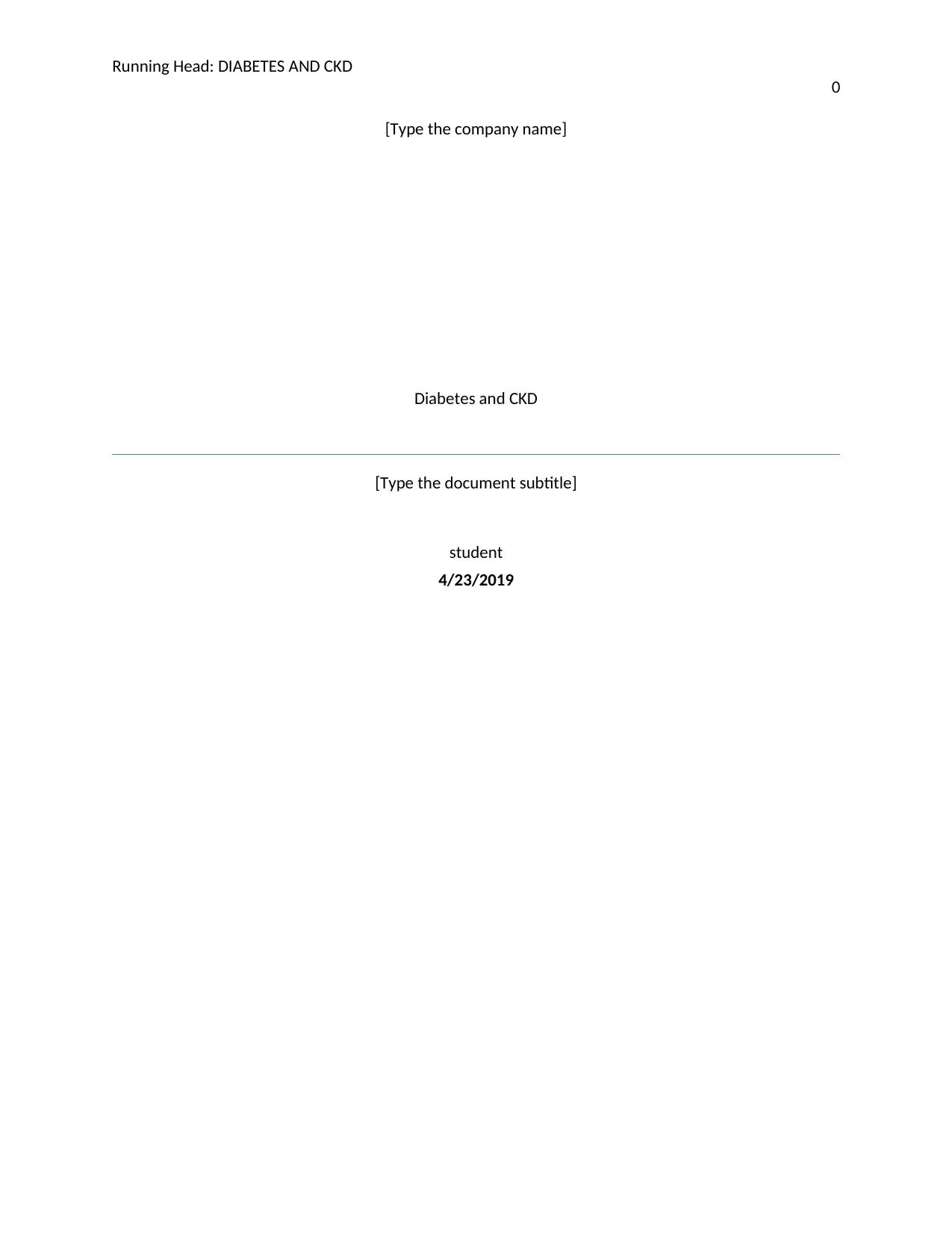
Running Head: DIABETES AND CKD
0
[Type the company name]
Diabetes and CKD
[Type the document subtitle]
student
4/23/2019
0
[Type the company name]
Diabetes and CKD
[Type the document subtitle]
student
4/23/2019
Secure Best Marks with AI Grader
Need help grading? Try our AI Grader for instant feedback on your assignments.
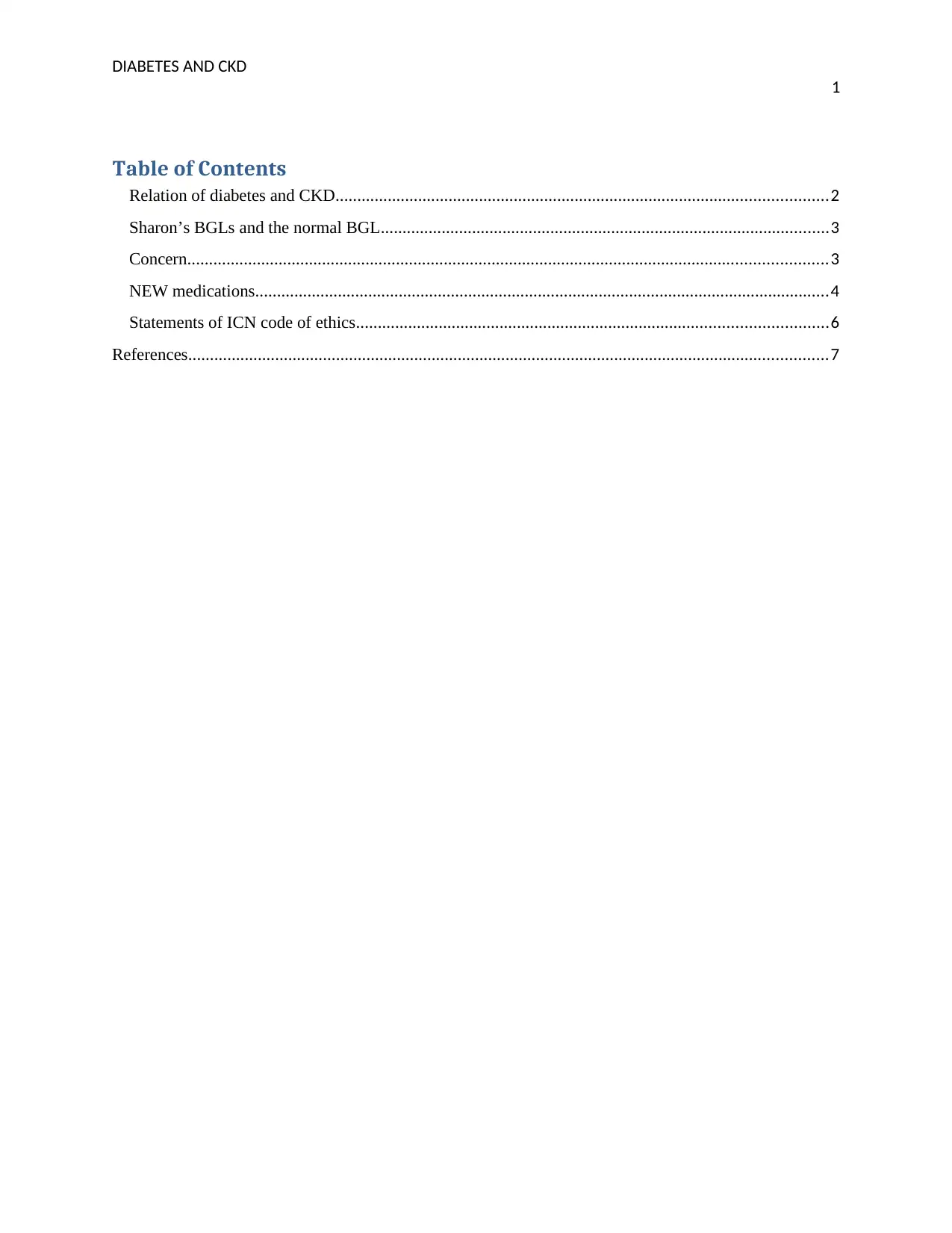
DIABETES AND CKD
1
Table of Contents
Relation of diabetes and CKD.................................................................................................................2
Sharon’s BGLs and the normal BGL.......................................................................................................3
Concern...................................................................................................................................................3
NEW medications....................................................................................................................................4
Statements of ICN code of ethics............................................................................................................6
References...................................................................................................................................................7
1
Table of Contents
Relation of diabetes and CKD.................................................................................................................2
Sharon’s BGLs and the normal BGL.......................................................................................................3
Concern...................................................................................................................................................3
NEW medications....................................................................................................................................4
Statements of ICN code of ethics............................................................................................................6
References...................................................................................................................................................7
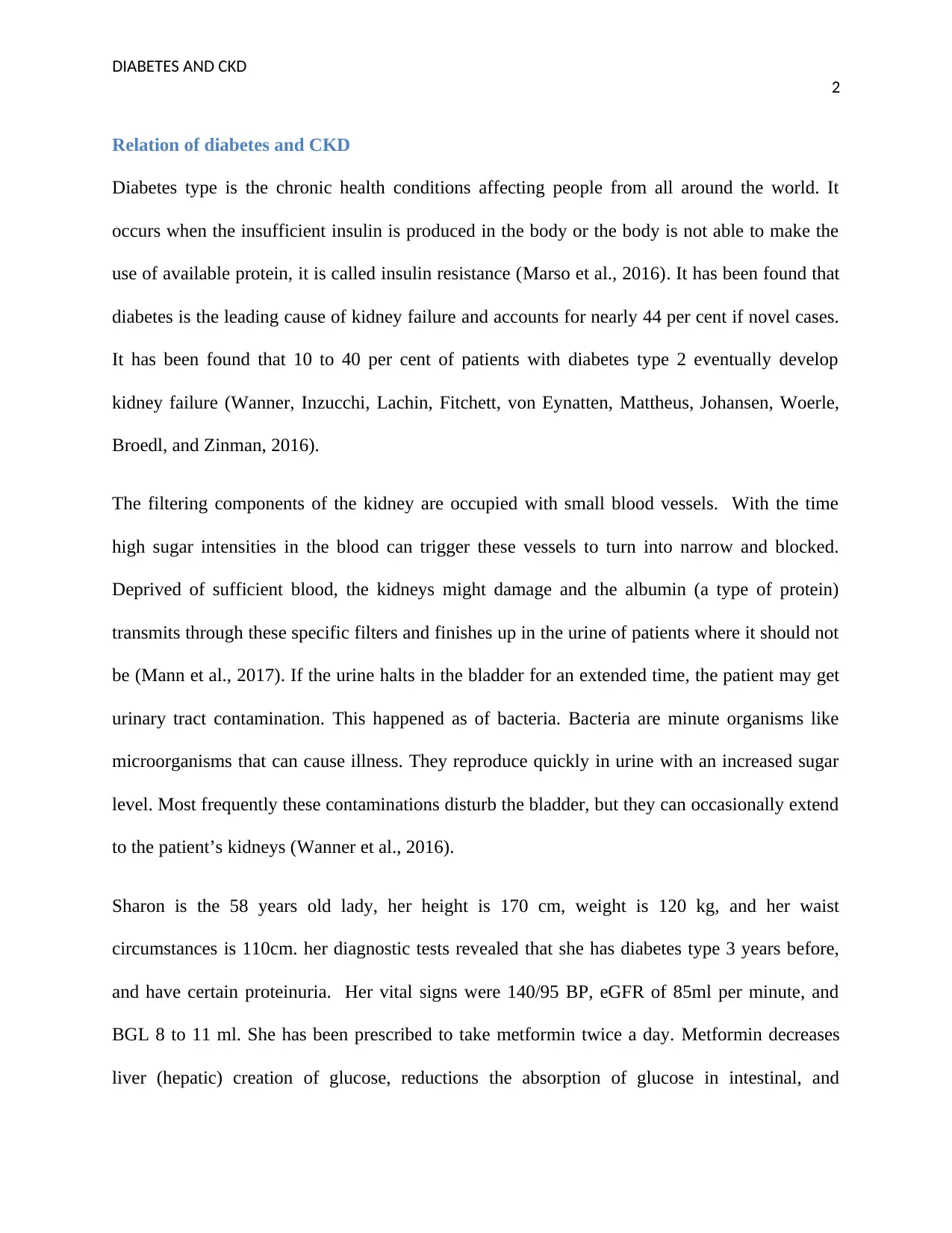
DIABETES AND CKD
2
Relation of diabetes and CKD
Diabetes type is the chronic health conditions affecting people from all around the world. It
occurs when the insufficient insulin is produced in the body or the body is not able to make the
use of available protein, it is called insulin resistance (Marso et al., 2016). It has been found that
diabetes is the leading cause of kidney failure and accounts for nearly 44 per cent if novel cases.
It has been found that 10 to 40 per cent of patients with diabetes type 2 eventually develop
kidney failure (Wanner, Inzucchi, Lachin, Fitchett, von Eynatten, Mattheus, Johansen, Woerle,
Broedl, and Zinman, 2016).
The filtering components of the kidney are occupied with small blood vessels. With the time
high sugar intensities in the blood can trigger these vessels to turn into narrow and blocked.
Deprived of sufficient blood, the kidneys might damage and the albumin (a type of protein)
transmits through these specific filters and finishes up in the urine of patients where it should not
be (Mann et al., 2017). If the urine halts in the bladder for an extended time, the patient may get
urinary tract contamination. This happened as of bacteria. Bacteria are minute organisms like
microorganisms that can cause illness. They reproduce quickly in urine with an increased sugar
level. Most frequently these contaminations disturb the bladder, but they can occasionally extend
to the patient’s kidneys (Wanner et al., 2016).
Sharon is the 58 years old lady, her height is 170 cm, weight is 120 kg, and her waist
circumstances is 110cm. her diagnostic tests revealed that she has diabetes type 3 years before,
and have certain proteinuria. Her vital signs were 140/95 BP, eGFR of 85ml per minute, and
BGL 8 to 11 ml. She has been prescribed to take metformin twice a day. Metformin decreases
liver (hepatic) creation of glucose, reductions the absorption of glucose in intestinal, and
2
Relation of diabetes and CKD
Diabetes type is the chronic health conditions affecting people from all around the world. It
occurs when the insufficient insulin is produced in the body or the body is not able to make the
use of available protein, it is called insulin resistance (Marso et al., 2016). It has been found that
diabetes is the leading cause of kidney failure and accounts for nearly 44 per cent if novel cases.
It has been found that 10 to 40 per cent of patients with diabetes type 2 eventually develop
kidney failure (Wanner, Inzucchi, Lachin, Fitchett, von Eynatten, Mattheus, Johansen, Woerle,
Broedl, and Zinman, 2016).
The filtering components of the kidney are occupied with small blood vessels. With the time
high sugar intensities in the blood can trigger these vessels to turn into narrow and blocked.
Deprived of sufficient blood, the kidneys might damage and the albumin (a type of protein)
transmits through these specific filters and finishes up in the urine of patients where it should not
be (Mann et al., 2017). If the urine halts in the bladder for an extended time, the patient may get
urinary tract contamination. This happened as of bacteria. Bacteria are minute organisms like
microorganisms that can cause illness. They reproduce quickly in urine with an increased sugar
level. Most frequently these contaminations disturb the bladder, but they can occasionally extend
to the patient’s kidneys (Wanner et al., 2016).
Sharon is the 58 years old lady, her height is 170 cm, weight is 120 kg, and her waist
circumstances is 110cm. her diagnostic tests revealed that she has diabetes type 3 years before,
and have certain proteinuria. Her vital signs were 140/95 BP, eGFR of 85ml per minute, and
BGL 8 to 11 ml. She has been prescribed to take metformin twice a day. Metformin decreases
liver (hepatic) creation of glucose, reductions the absorption of glucose in intestinal, and

DIABETES AND CKD
3
improves insulin sensitivity by growing uptake and utilization of peripheral glucose. In disparity
with medicines of the sulfonylurea category, which results in hyperinsulinemia, the excretion of
insulin is unaffected with metformin usage. In a 29-week scientific trial of subjects identified
with type II diabetes, metformin reduced the abstaining stages of plasma glucose by a usual of 59
mg/dL from the baseline (Forslund, Hildebrand, Nielsen, Falony, Le Chatelier, Sunagawa, Prifti,
Vieira-Silva, Gudmundsdottir, Pedersen, and Arumugam, 2015)
Sharon’s BGLs and the normal BGL
The blood glucose levels of Sharon were measured as 8 to 11 mmol/l in the day time and 7 to 8
mmol/L in the morning. The normal ranges of BGL in a healthy person are between, 4.0 to 5.4
mmol/L when fasting and up to 7.8 mmol/L two hours after having a meal. Therefore It can be
said the BGL levels in case of Sharon are higher and indicates that she might have
hyperglycaemia in future. For the patient with diabetes type 1 and 2 the levels of BGL should be
4 to 7 mmol/L before meals or daytime and should be under 9 mmol/L and below 8.5 mmol/L
for patients with diabetes type 2. In the case of Sharon, those levels were higher and need to be
controlled (Siu, 2015).
Concern
Sharon has been recommending that she needs to add Glucovance 500 mg/2.5 mg to with her
present medications list. Glucovance (glyburide/metformin) is the mixture antidiabetic drug
comprising glyburide and metformin. The drug Glucovance is generally used to enhance the
blood glucose (sugar) regulation in grown-ups with diabetes type two.in the case of Sharon, my
main concern related to this medication is the side effects that may affect her adversely.
Although, the prescribed dosage of this drug, are suitable and safe, mixing drugs with other
3
improves insulin sensitivity by growing uptake and utilization of peripheral glucose. In disparity
with medicines of the sulfonylurea category, which results in hyperinsulinemia, the excretion of
insulin is unaffected with metformin usage. In a 29-week scientific trial of subjects identified
with type II diabetes, metformin reduced the abstaining stages of plasma glucose by a usual of 59
mg/dL from the baseline (Forslund, Hildebrand, Nielsen, Falony, Le Chatelier, Sunagawa, Prifti,
Vieira-Silva, Gudmundsdottir, Pedersen, and Arumugam, 2015)
Sharon’s BGLs and the normal BGL
The blood glucose levels of Sharon were measured as 8 to 11 mmol/l in the day time and 7 to 8
mmol/L in the morning. The normal ranges of BGL in a healthy person are between, 4.0 to 5.4
mmol/L when fasting and up to 7.8 mmol/L two hours after having a meal. Therefore It can be
said the BGL levels in case of Sharon are higher and indicates that she might have
hyperglycaemia in future. For the patient with diabetes type 1 and 2 the levels of BGL should be
4 to 7 mmol/L before meals or daytime and should be under 9 mmol/L and below 8.5 mmol/L
for patients with diabetes type 2. In the case of Sharon, those levels were higher and need to be
controlled (Siu, 2015).
Concern
Sharon has been recommending that she needs to add Glucovance 500 mg/2.5 mg to with her
present medications list. Glucovance (glyburide/metformin) is the mixture antidiabetic drug
comprising glyburide and metformin. The drug Glucovance is generally used to enhance the
blood glucose (sugar) regulation in grown-ups with diabetes type two.in the case of Sharon, my
main concern related to this medication is the side effects that may affect her adversely.
Although, the prescribed dosage of this drug, are suitable and safe, mixing drugs with other
Secure Best Marks with AI Grader
Need help grading? Try our AI Grader for instant feedback on your assignments.

DIABETES AND CKD
4
drugs often caused different adverse reactions (Qaseem, Barry, Humphrey, and Forciea, 2017).
Some of the negative impacts that may arise after administrations of Glucovance include
stomach pain, diarrhea, upset stomach, nausea, vomiting, headache and dizziness. Other usually
observed adverse effects of this drug therapy include reduced appetite, metallic taste, gas,
heartburn, and weight loss (Smith, Mills, and Carlisle, 2016). Sharon may also develop other
side effects like hypoglycemia, a blood disorder, and reduced blood sodium levels, rashes on the
skin, sensitivity to the sunlight, itching, liver-associated disorders, SIADG, hives, and
hypersensitivity type reactions. Metformin while including other drugs may develop rare but
severe health conditions like lactic acidosis, which is the development of acid in the blood. This
particular acid may cause death (Qaseem, et al., 2017). As discussed in the case study Mrs
Sharon is old lady, therefore developing the symptoms in her case may enhance the chances of a
worse condition. Mrs Sharon had increased levels of blood glucose levels in the body, and she is
already at risk of developing hyperglycemia and negative impacts like hypoglycemia, of this
combined drug therapy may develop additional health issues.
NEW medications
Diabetes is the greatest significant risk aspects of chronic kidney disease (CKD). The threat of
CKD attributable to diabetes endures raising universal. Diabetic patients having CKD require
complex dealing for their metabolic illnesses as well as for connected problems. They have to
cure, frequently intensively, bone disease hypertension, anaemia dyslipidaemia, and regularly
established cardiovascular disorder (Thomas, Cooper, and Zimmet, 2016). Mrs Sharon has
developed both diabetes and chronic kidney disease. Although the best available medications are
prescribed, by the physician to resolve the symptoms, there are some serious symptoms
4
drugs often caused different adverse reactions (Qaseem, Barry, Humphrey, and Forciea, 2017).
Some of the negative impacts that may arise after administrations of Glucovance include
stomach pain, diarrhea, upset stomach, nausea, vomiting, headache and dizziness. Other usually
observed adverse effects of this drug therapy include reduced appetite, metallic taste, gas,
heartburn, and weight loss (Smith, Mills, and Carlisle, 2016). Sharon may also develop other
side effects like hypoglycemia, a blood disorder, and reduced blood sodium levels, rashes on the
skin, sensitivity to the sunlight, itching, liver-associated disorders, SIADG, hives, and
hypersensitivity type reactions. Metformin while including other drugs may develop rare but
severe health conditions like lactic acidosis, which is the development of acid in the blood. This
particular acid may cause death (Qaseem, et al., 2017). As discussed in the case study Mrs
Sharon is old lady, therefore developing the symptoms in her case may enhance the chances of a
worse condition. Mrs Sharon had increased levels of blood glucose levels in the body, and she is
already at risk of developing hyperglycemia and negative impacts like hypoglycemia, of this
combined drug therapy may develop additional health issues.
NEW medications
Diabetes is the greatest significant risk aspects of chronic kidney disease (CKD). The threat of
CKD attributable to diabetes endures raising universal. Diabetic patients having CKD require
complex dealing for their metabolic illnesses as well as for connected problems. They have to
cure, frequently intensively, bone disease hypertension, anaemia dyslipidaemia, and regularly
established cardiovascular disorder (Thomas, Cooper, and Zimmet, 2016). Mrs Sharon has
developed both diabetes and chronic kidney disease. Although the best available medications are
prescribed, by the physician to resolve the symptoms, there are some serious symptoms
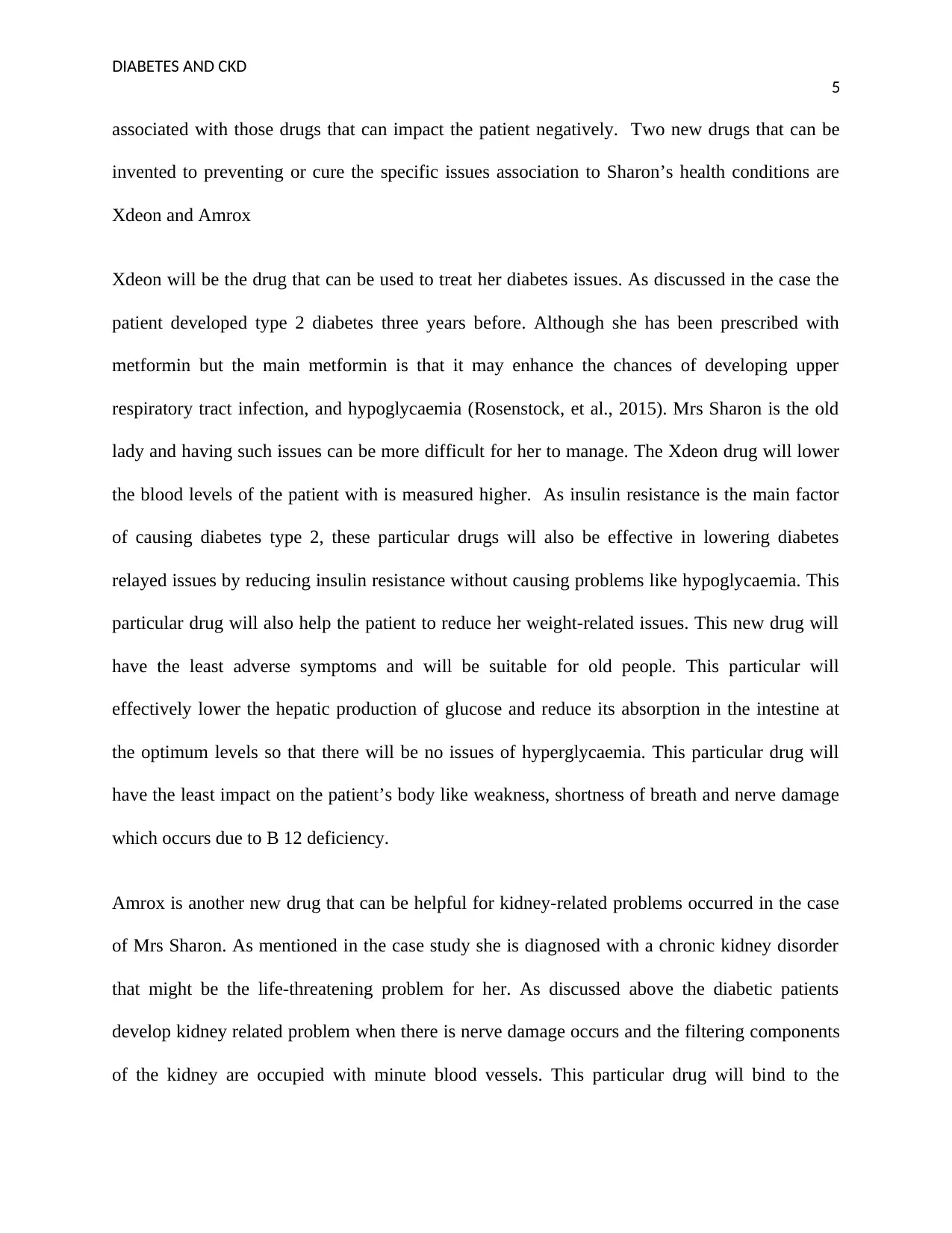
DIABETES AND CKD
5
associated with those drugs that can impact the patient negatively. Two new drugs that can be
invented to preventing or cure the specific issues association to Sharon’s health conditions are
Xdeon and Amrox
Xdeon will be the drug that can be used to treat her diabetes issues. As discussed in the case the
patient developed type 2 diabetes three years before. Although she has been prescribed with
metformin but the main metformin is that it may enhance the chances of developing upper
respiratory tract infection, and hypoglycaemia (Rosenstock, et al., 2015). Mrs Sharon is the old
lady and having such issues can be more difficult for her to manage. The Xdeon drug will lower
the blood levels of the patient with is measured higher. As insulin resistance is the main factor
of causing diabetes type 2, these particular drugs will also be effective in lowering diabetes
relayed issues by reducing insulin resistance without causing problems like hypoglycaemia. This
particular drug will also help the patient to reduce her weight-related issues. This new drug will
have the least adverse symptoms and will be suitable for old people. This particular will
effectively lower the hepatic production of glucose and reduce its absorption in the intestine at
the optimum levels so that there will be no issues of hyperglycaemia. This particular drug will
have the least impact on the patient’s body like weakness, shortness of breath and nerve damage
which occurs due to B 12 deficiency.
Amrox is another new drug that can be helpful for kidney-related problems occurred in the case
of Mrs Sharon. As mentioned in the case study she is diagnosed with a chronic kidney disorder
that might be the life-threatening problem for her. As discussed above the diabetic patients
develop kidney related problem when there is nerve damage occurs and the filtering components
of the kidney are occupied with minute blood vessels. This particular drug will bind to the
5
associated with those drugs that can impact the patient negatively. Two new drugs that can be
invented to preventing or cure the specific issues association to Sharon’s health conditions are
Xdeon and Amrox
Xdeon will be the drug that can be used to treat her diabetes issues. As discussed in the case the
patient developed type 2 diabetes three years before. Although she has been prescribed with
metformin but the main metformin is that it may enhance the chances of developing upper
respiratory tract infection, and hypoglycaemia (Rosenstock, et al., 2015). Mrs Sharon is the old
lady and having such issues can be more difficult for her to manage. The Xdeon drug will lower
the blood levels of the patient with is measured higher. As insulin resistance is the main factor
of causing diabetes type 2, these particular drugs will also be effective in lowering diabetes
relayed issues by reducing insulin resistance without causing problems like hypoglycaemia. This
particular drug will also help the patient to reduce her weight-related issues. This new drug will
have the least adverse symptoms and will be suitable for old people. This particular will
effectively lower the hepatic production of glucose and reduce its absorption in the intestine at
the optimum levels so that there will be no issues of hyperglycaemia. This particular drug will
have the least impact on the patient’s body like weakness, shortness of breath and nerve damage
which occurs due to B 12 deficiency.
Amrox is another new drug that can be helpful for kidney-related problems occurred in the case
of Mrs Sharon. As mentioned in the case study she is diagnosed with a chronic kidney disorder
that might be the life-threatening problem for her. As discussed above the diabetic patients
develop kidney related problem when there is nerve damage occurs and the filtering components
of the kidney are occupied with minute blood vessels. This particular drug will bind to the
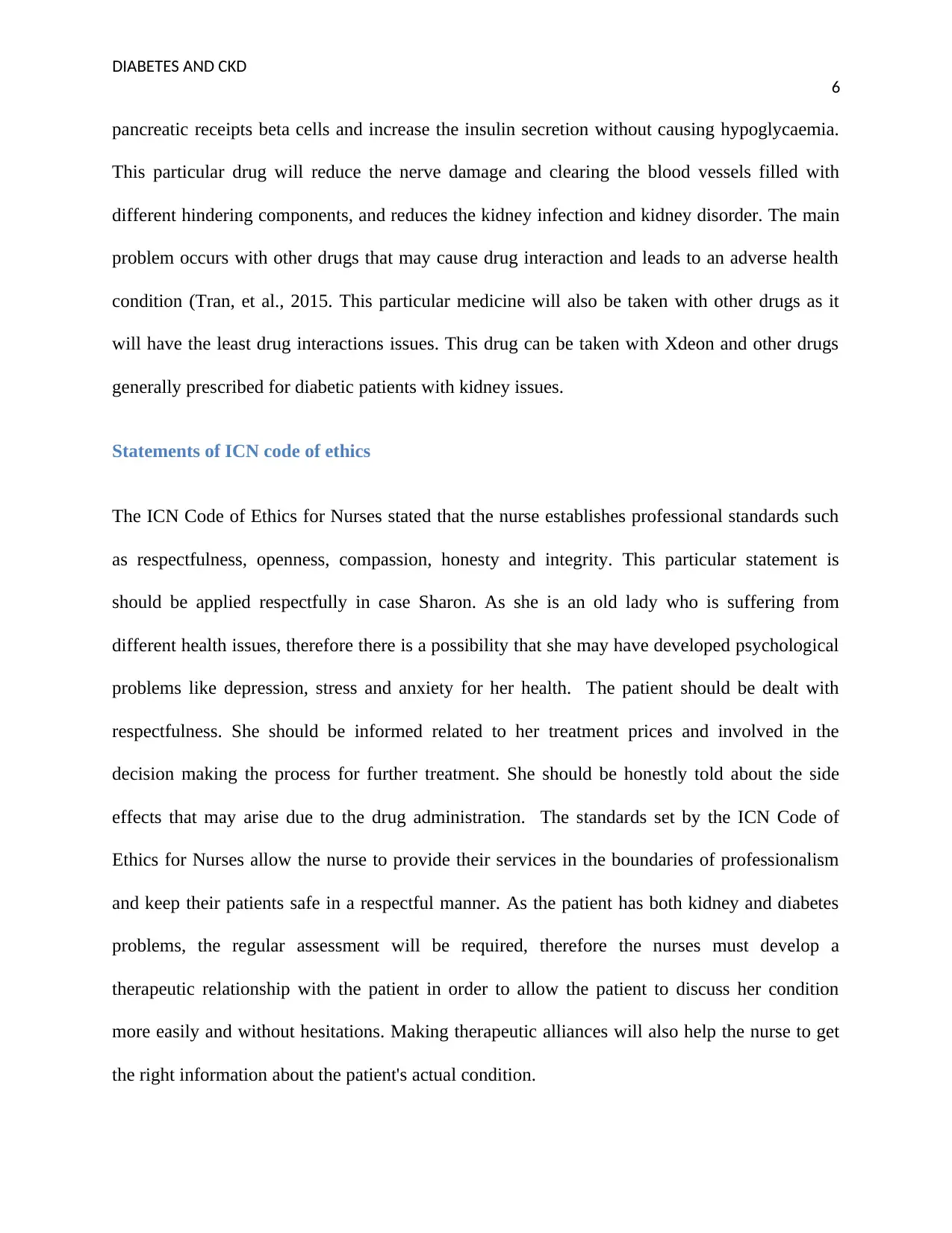
DIABETES AND CKD
6
pancreatic receipts beta cells and increase the insulin secretion without causing hypoglycaemia.
This particular drug will reduce the nerve damage and clearing the blood vessels filled with
different hindering components, and reduces the kidney infection and kidney disorder. The main
problem occurs with other drugs that may cause drug interaction and leads to an adverse health
condition (Tran, et al., 2015. This particular medicine will also be taken with other drugs as it
will have the least drug interactions issues. This drug can be taken with Xdeon and other drugs
generally prescribed for diabetic patients with kidney issues.
Statements of ICN code of ethics
The ICN Code of Ethics for Nurses stated that the nurse establishes professional standards such
as respectfulness, openness, compassion, honesty and integrity. This particular statement is
should be applied respectfully in case Sharon. As she is an old lady who is suffering from
different health issues, therefore there is a possibility that she may have developed psychological
problems like depression, stress and anxiety for her health. The patient should be dealt with
respectfulness. She should be informed related to her treatment prices and involved in the
decision making the process for further treatment. She should be honestly told about the side
effects that may arise due to the drug administration. The standards set by the ICN Code of
Ethics for Nurses allow the nurse to provide their services in the boundaries of professionalism
and keep their patients safe in a respectful manner. As the patient has both kidney and diabetes
problems, the regular assessment will be required, therefore the nurses must develop a
therapeutic relationship with the patient in order to allow the patient to discuss her condition
more easily and without hesitations. Making therapeutic alliances will also help the nurse to get
the right information about the patient's actual condition.
6
pancreatic receipts beta cells and increase the insulin secretion without causing hypoglycaemia.
This particular drug will reduce the nerve damage and clearing the blood vessels filled with
different hindering components, and reduces the kidney infection and kidney disorder. The main
problem occurs with other drugs that may cause drug interaction and leads to an adverse health
condition (Tran, et al., 2015. This particular medicine will also be taken with other drugs as it
will have the least drug interactions issues. This drug can be taken with Xdeon and other drugs
generally prescribed for diabetic patients with kidney issues.
Statements of ICN code of ethics
The ICN Code of Ethics for Nurses stated that the nurse establishes professional standards such
as respectfulness, openness, compassion, honesty and integrity. This particular statement is
should be applied respectfully in case Sharon. As she is an old lady who is suffering from
different health issues, therefore there is a possibility that she may have developed psychological
problems like depression, stress and anxiety for her health. The patient should be dealt with
respectfulness. She should be informed related to her treatment prices and involved in the
decision making the process for further treatment. She should be honestly told about the side
effects that may arise due to the drug administration. The standards set by the ICN Code of
Ethics for Nurses allow the nurse to provide their services in the boundaries of professionalism
and keep their patients safe in a respectful manner. As the patient has both kidney and diabetes
problems, the regular assessment will be required, therefore the nurses must develop a
therapeutic relationship with the patient in order to allow the patient to discuss her condition
more easily and without hesitations. Making therapeutic alliances will also help the nurse to get
the right information about the patient's actual condition.
Paraphrase This Document
Need a fresh take? Get an instant paraphrase of this document with our AI Paraphraser
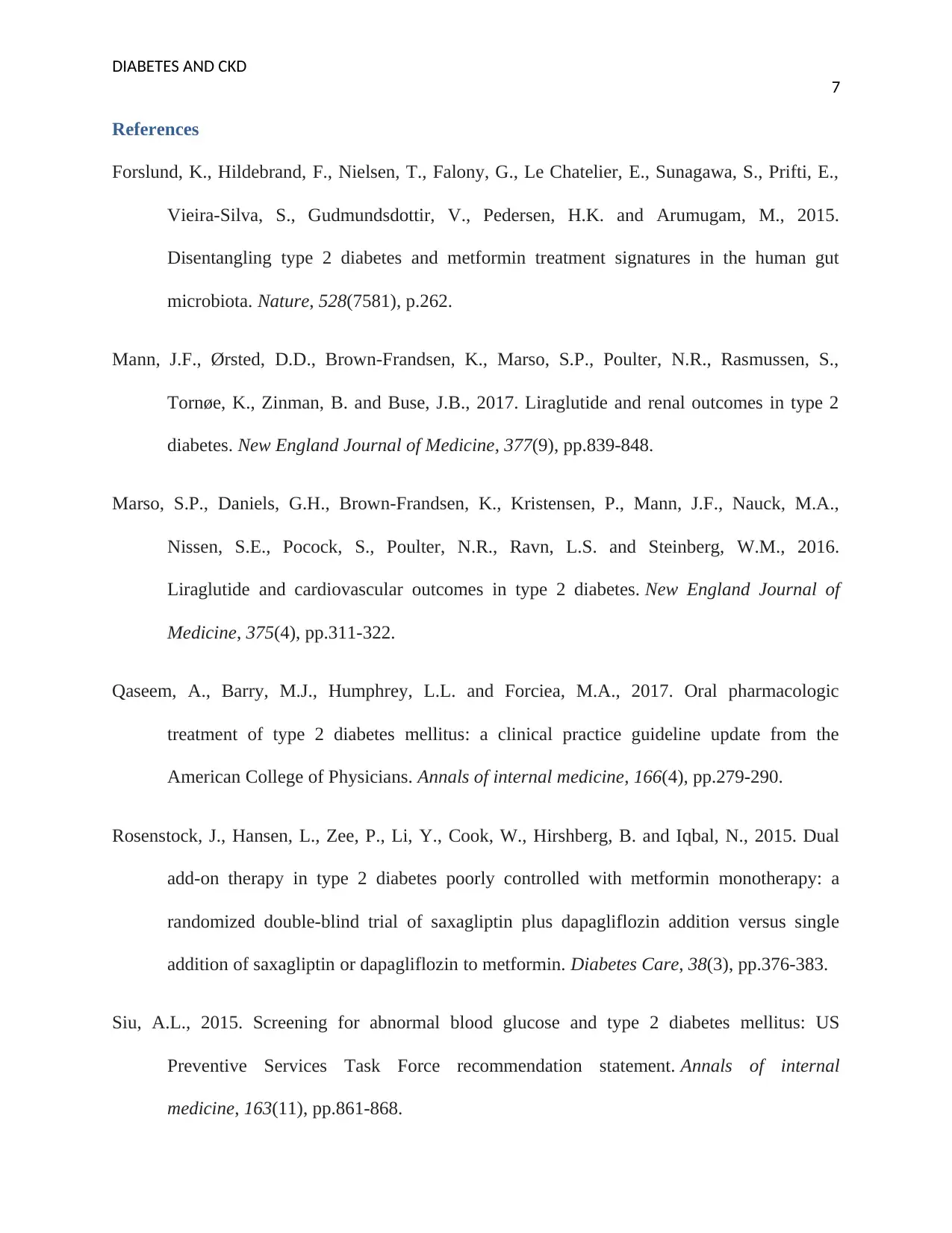
DIABETES AND CKD
7
References
Forslund, K., Hildebrand, F., Nielsen, T., Falony, G., Le Chatelier, E., Sunagawa, S., Prifti, E.,
Vieira-Silva, S., Gudmundsdottir, V., Pedersen, H.K. and Arumugam, M., 2015.
Disentangling type 2 diabetes and metformin treatment signatures in the human gut
microbiota. Nature, 528(7581), p.262.
Mann, J.F., Ørsted, D.D., Brown-Frandsen, K., Marso, S.P., Poulter, N.R., Rasmussen, S.,
Tornøe, K., Zinman, B. and Buse, J.B., 2017. Liraglutide and renal outcomes in type 2
diabetes. New England Journal of Medicine, 377(9), pp.839-848.
Marso, S.P., Daniels, G.H., Brown-Frandsen, K., Kristensen, P., Mann, J.F., Nauck, M.A.,
Nissen, S.E., Pocock, S., Poulter, N.R., Ravn, L.S. and Steinberg, W.M., 2016.
Liraglutide and cardiovascular outcomes in type 2 diabetes. New England Journal of
Medicine, 375(4), pp.311-322.
Qaseem, A., Barry, M.J., Humphrey, L.L. and Forciea, M.A., 2017. Oral pharmacologic
treatment of type 2 diabetes mellitus: a clinical practice guideline update from the
American College of Physicians. Annals of internal medicine, 166(4), pp.279-290.
Rosenstock, J., Hansen, L., Zee, P., Li, Y., Cook, W., Hirshberg, B. and Iqbal, N., 2015. Dual
add-on therapy in type 2 diabetes poorly controlled with metformin monotherapy: a
randomized double-blind trial of saxagliptin plus dapagliflozin addition versus single
addition of saxagliptin or dapagliflozin to metformin. Diabetes Care, 38(3), pp.376-383.
Siu, A.L., 2015. Screening for abnormal blood glucose and type 2 diabetes mellitus: US
Preventive Services Task Force recommendation statement. Annals of internal
medicine, 163(11), pp.861-868.
7
References
Forslund, K., Hildebrand, F., Nielsen, T., Falony, G., Le Chatelier, E., Sunagawa, S., Prifti, E.,
Vieira-Silva, S., Gudmundsdottir, V., Pedersen, H.K. and Arumugam, M., 2015.
Disentangling type 2 diabetes and metformin treatment signatures in the human gut
microbiota. Nature, 528(7581), p.262.
Mann, J.F., Ørsted, D.D., Brown-Frandsen, K., Marso, S.P., Poulter, N.R., Rasmussen, S.,
Tornøe, K., Zinman, B. and Buse, J.B., 2017. Liraglutide and renal outcomes in type 2
diabetes. New England Journal of Medicine, 377(9), pp.839-848.
Marso, S.P., Daniels, G.H., Brown-Frandsen, K., Kristensen, P., Mann, J.F., Nauck, M.A.,
Nissen, S.E., Pocock, S., Poulter, N.R., Ravn, L.S. and Steinberg, W.M., 2016.
Liraglutide and cardiovascular outcomes in type 2 diabetes. New England Journal of
Medicine, 375(4), pp.311-322.
Qaseem, A., Barry, M.J., Humphrey, L.L. and Forciea, M.A., 2017. Oral pharmacologic
treatment of type 2 diabetes mellitus: a clinical practice guideline update from the
American College of Physicians. Annals of internal medicine, 166(4), pp.279-290.
Rosenstock, J., Hansen, L., Zee, P., Li, Y., Cook, W., Hirshberg, B. and Iqbal, N., 2015. Dual
add-on therapy in type 2 diabetes poorly controlled with metformin monotherapy: a
randomized double-blind trial of saxagliptin plus dapagliflozin addition versus single
addition of saxagliptin or dapagliflozin to metformin. Diabetes Care, 38(3), pp.376-383.
Siu, A.L., 2015. Screening for abnormal blood glucose and type 2 diabetes mellitus: US
Preventive Services Task Force recommendation statement. Annals of internal
medicine, 163(11), pp.861-868.
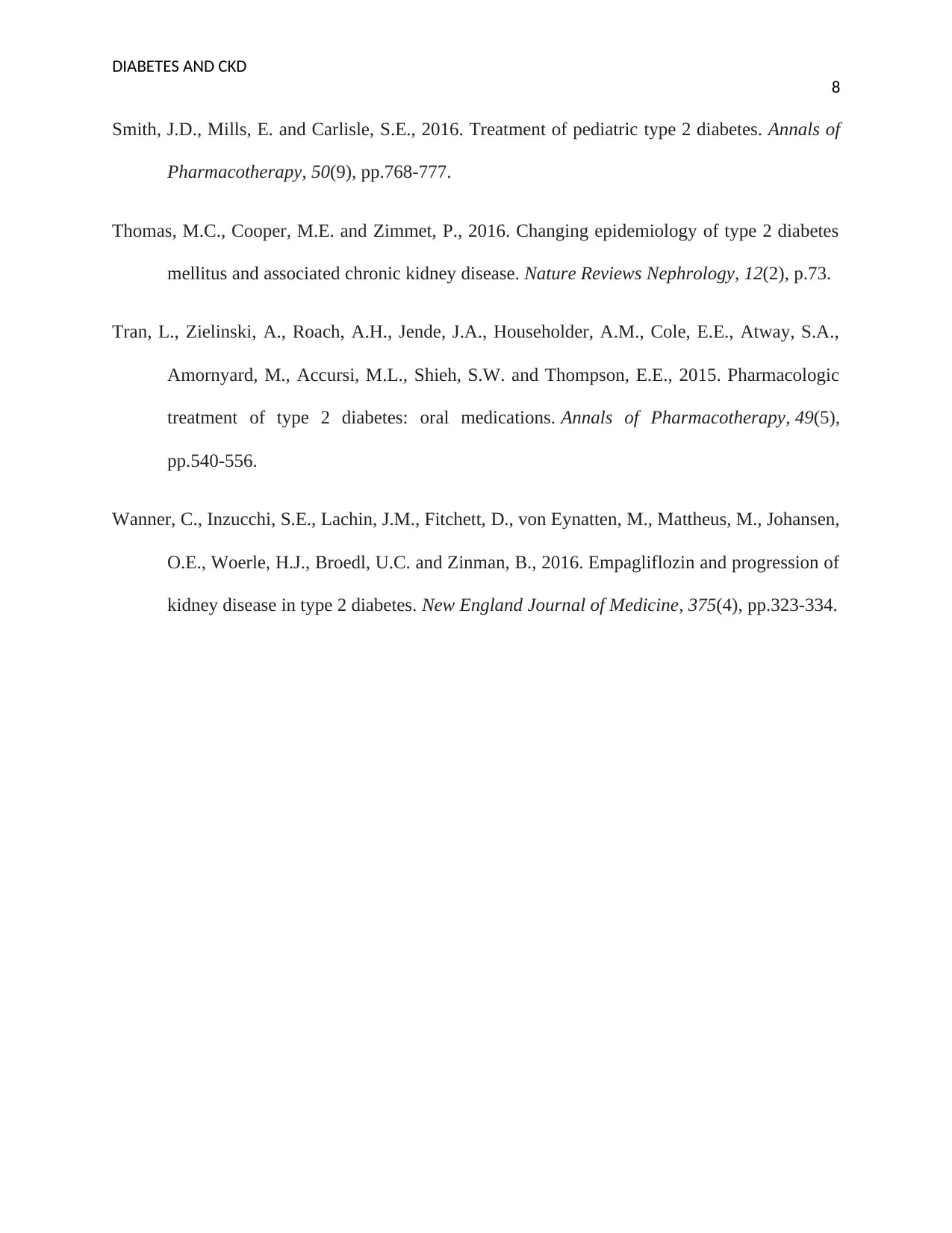
DIABETES AND CKD
8
Smith, J.D., Mills, E. and Carlisle, S.E., 2016. Treatment of pediatric type 2 diabetes. Annals of
Pharmacotherapy, 50(9), pp.768-777.
Thomas, M.C., Cooper, M.E. and Zimmet, P., 2016. Changing epidemiology of type 2 diabetes
mellitus and associated chronic kidney disease. Nature Reviews Nephrology, 12(2), p.73.
Tran, L., Zielinski, A., Roach, A.H., Jende, J.A., Householder, A.M., Cole, E.E., Atway, S.A.,
Amornyard, M., Accursi, M.L., Shieh, S.W. and Thompson, E.E., 2015. Pharmacologic
treatment of type 2 diabetes: oral medications. Annals of Pharmacotherapy, 49(5),
pp.540-556.
Wanner, C., Inzucchi, S.E., Lachin, J.M., Fitchett, D., von Eynatten, M., Mattheus, M., Johansen,
O.E., Woerle, H.J., Broedl, U.C. and Zinman, B., 2016. Empagliflozin and progression of
kidney disease in type 2 diabetes. New England Journal of Medicine, 375(4), pp.323-334.
8
Smith, J.D., Mills, E. and Carlisle, S.E., 2016. Treatment of pediatric type 2 diabetes. Annals of
Pharmacotherapy, 50(9), pp.768-777.
Thomas, M.C., Cooper, M.E. and Zimmet, P., 2016. Changing epidemiology of type 2 diabetes
mellitus and associated chronic kidney disease. Nature Reviews Nephrology, 12(2), p.73.
Tran, L., Zielinski, A., Roach, A.H., Jende, J.A., Householder, A.M., Cole, E.E., Atway, S.A.,
Amornyard, M., Accursi, M.L., Shieh, S.W. and Thompson, E.E., 2015. Pharmacologic
treatment of type 2 diabetes: oral medications. Annals of Pharmacotherapy, 49(5),
pp.540-556.
Wanner, C., Inzucchi, S.E., Lachin, J.M., Fitchett, D., von Eynatten, M., Mattheus, M., Johansen,
O.E., Woerle, H.J., Broedl, U.C. and Zinman, B., 2016. Empagliflozin and progression of
kidney disease in type 2 diabetes. New England Journal of Medicine, 375(4), pp.323-334.
1 out of 9
Related Documents
Your All-in-One AI-Powered Toolkit for Academic Success.
+13062052269
info@desklib.com
Available 24*7 on WhatsApp / Email
![[object Object]](/_next/static/media/star-bottom.7253800d.svg)
Unlock your academic potential
© 2024 | Zucol Services PVT LTD | All rights reserved.





